Book contents
- Introduction to Computable General Equilibrium Models
- Introduction to Computable General Equilibrium Models
- Copyright page
- Dedication
- Contents
- Figures
- Tables
- Text Boxes
- Acknowledgments
- About This Book
- 1 Introduction to Computable General Equilibrium Models
- 2 Elements of a Computable General Equilibrium Model
- 3 The CGE Model Database
- 4 Final Demand in a CGE Model
- 5 Supply in a CGE Model
- 6 Factors of Production in a CGE Model
- 7 Trade in a CGE Model
- 8 Taxes in a CGE Model
- 9 Regulations in a CGE Model
- 10 Conclusion
- Model Exercises
- Practice and Review Answer Key
- Model Exercise Answer Key
- Book part
- Glossary
- References
- Author Index
- Subject Index
- References
References
Published online by Cambridge University Press: 11 December 2020
- Introduction to Computable General Equilibrium Models
- Introduction to Computable General Equilibrium Models
- Copyright page
- Dedication
- Contents
- Figures
- Tables
- Text Boxes
- Acknowledgments
- About This Book
- 1 Introduction to Computable General Equilibrium Models
- 2 Elements of a Computable General Equilibrium Model
- 3 The CGE Model Database
- 4 Final Demand in a CGE Model
- 5 Supply in a CGE Model
- 6 Factors of Production in a CGE Model
- 7 Trade in a CGE Model
- 8 Taxes in a CGE Model
- 9 Regulations in a CGE Model
- 10 Conclusion
- Model Exercises
- Practice and Review Answer Key
- Model Exercise Answer Key
- Book part
- Glossary
- References
- Author Index
- Subject Index
- References
- Type
- Chapter
- Information
- Introduction to Computable General Equilibrium Models , pp. 455 - 467Publisher: Cambridge University PressPrint publication year: 2021

